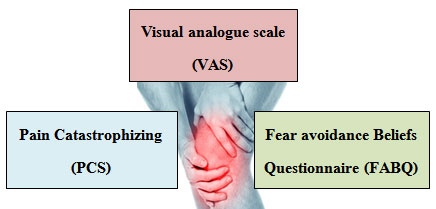ความน่าเชื่อถือและความสัมพันธ์ของเครื่องมือในการประเมินอาการปวดข้อเข่าใต้กระดูกสะบ้าเรื้อรังในกลุ่มนักศึกษามหาวิทยาลัย
คำสำคัญ:
การทดสอบและทดสอบซ้ำ, อาการปวดข้อเข่าใต้กระดูกสะบ้าเรื้อรัง, ความกลัวและการถอยหนี, ความคิดเชิงลบต่อความปวดบทคัดย่อ
อาการปวดข้อเข่าใต้กระดูกสะบ้าเรื้อรังส่งผลกระทบทั้งทางด้านร่างกายและจิตใจ การตรวจประเมินแยกโรค และอาการต่างๆที่เกิดขึ้นจากพยาธิภาพของโรคจึงมีความสำคัญและเป็นประโยชน์ต่อการวางแผนการป้องกันรักษาอาการดังกล่าว การศึกษานี้มีวัตถุประสงค์เพื่อศึกษาความน่าเชื่อถือและความสัมพันธ์ระหว่างความน่าเชื่อถือของเครื่องมือวิจัยที่ใช้วัดและผลการประเมินด้านร่างกายและจิตใจในนิสิตที่มีอาการดังกล่าว เครื่องมือในการศึกษาประกอบด้วย แบบสอบถามระดับอาการปวด แบบสอบถามความคิดเชิงลบต่อความปวด ฉบับภาษาไทย และความเชื่อเกี่ยวกับความกลัวและการถอยหนีจากอาการปวดฉบับภาษาไทย ให้อาสาสมัครที่มีอาการปวดข้อเข่าทางด้านหน้ามากกว่า 3 เดือน ช่วงอายุ 19-25 ปี จำนวน 34 คน ตอบแบบสอบถามทั้งหมดจำนวน 2 ครั้ง เว้นระยะเวลาห่างกัน 30 นาที จึงนำมาหาค่าความน่าเชื่อถือของเครื่องมือวิจัยด้วยการทดสอบและทดสอบซ้ำด้วยสถิติสัมประสิทธิ์สหสัมพันธ์ภายในชั้น (ICC3,1)และหาความสัมพันธ์ระหว่างค่าเฉลี่ยของแต่ละตัวแปร ด้วยสัมประสิทธิ์สหสัมพันธ์ของเพียร์สัน(r) ผลการศึกษา พบว่า ความน่าเชื่อถือของเครื่องมือที่ใช้วัดระดับอาการปวดข้อเข่าทางด้านหน้าเรื้อรังอยู่ในระดับดีถึงดีมาก (ICC3,1=0.89-0.94) ความคิดเชิงลบต่อความปวดอยู่ในระดับดีมาก (ICC3,1=0.95) และความเชื่อเกี่ยวกับความกลัวและการถอยหนีจากอาการปวดอยู่ในระดับดี (ICC3,1=0.86) ยิ่งไปกว่านั้น ความคิดเชิงลบต่อความปวดสัมพันธ์กับ VAS-usual (r=0.36, p<0.05), VAS-jump (r=0.37, p<0.05,) และ VAS-worst (r=0.47, p<0.01) และ ความเชื่อเกี่ยวกับความกลัวและการถอยหนีจากอาการปวดสัมพันธ์กับ VAS-Squat (r=0.385, p<0.05) เครื่องมือวิจัยนี้มีความน่าเชื่อถือของการทดสอบและทดสอบซ้ำอยู่ในระดับดีถึงดีมาก สามารถใช้กับผู้ที่มีอาการปวดข้อเข่าใต้กระดูกสะบ้าเรื้อรังได้ทั้งด้านการวิจัยและการประเมินผลทางคลินิค และแสดงให้เห็นความสัมพันธ์ระหว่างระดับอาการปวดกับสภาวะจิตใจได้
Downloads
เอกสารอ้างอิง
Petersen W, Rembitzki I, Liebau C. Patellofe- moral pain in athletes. Open Access J Sports Med 2017; 12(8):143–54.
Crossley KM, Stefanik JJ, Selfe J, Collins NJ, Davis I, Powers CM, et al. Patellofemoral pain consensus statement from the 4th international patellofemoral pain research retreat, Manchester. Part 1: terminology, definitions, clinical examination, natural history, patellofemoral osteoarthritis and patient reported outcome measures.Br J Sports Med 2016:839–43.
Priore LB, Azevedo FM, Pazzinatto MF, Ferreira AS, Hart HF, Barton CB, et al. Influence of kinesiophobia and pain catastrophism on objective function in women with patellofemoral pain. Phys Ther Sport 2019; 35:116-21.
Smith BE, Moffatt F, Hendrick P, Bateman, Rathleff MS, Selfe J, et al. The experience of living with patellofemoral pain- loss, confusion and fear a voidance: a UK qualitative study. BMJ Open 2018.
Maclachlan LR, Matthews M, Hodges PW, Collins NJ, Vicenzino B. The psychological features of patellofemoral pain: a cross-sectional study. Scand J Pain 2017; 18(2): 261–71. https://doi.org/10.1515/sjpain-2018-0025.
Petersen W, Ellermann A, Gösele-Koppenburg A, Best R, Rembitzki IV, Brüggemann GP, et al. Patellofemoral pain syndrome. Knee Surg Sports Traumatol Arthrosc 2014; 22(10): 2264–74. https://doi.org/10.1007/s00167-013-2759-6.
Dey P, Callaghan M, Cook N. A questionnaire to identify patellofemoral pain in the community: an exploration of measurement properties. BMC Musculoskelet Disord 2016; 17:237.
Crossley KM, Bennell KL, Cowan SM, Green S. Analysis of Outcome Measures for Persons With Patellofemoral Pain: Which Are Reliable and Valid. Arch Phys Med Rehabil 2004;85: 815-22.
Koo TK, Li MY. A Guideline of Selecting and Reporting Intraclass Correlation Coefficients for Reliability Research. J Chiropr Med 2016; 15, 155-63.
Bennell K, Bartamet S, Crossley K, Green S. Outcome measures in patellofemoral pain syndrome: test retest reliability and inter-relationships. Phys Ther Sport 2000; 1:32-41.
Hanrungcharotorn U, Pinyopasakul W, Pongthavornkamol K, Dajpratham P. Beeber AS. Factors Influencing Physical Activity among Women with Osteoarthritis of the Knee. Pacific Rim Int J Nurs Res 2017; 21(1): 5-17.
Youngcharoen P, Aree-ue S and Saraboon Y. Validation of pain catastrophizing scale- thai version in older adults with osteoarthritis. Pacific Rim Int J Nurs Res 2018; 22(3): 236-47.
Green, A, Liles, C, Rushton, A, Kyte, DG. Measurement properties of patient-reported outcome measures (PROMS) in Patellofemoral Pain Syndrome: A systematic review. Man Ther 2014; 19: 517-26.
Sullivan MJ, Bishop SR, Pivik J. The pain catastrophizing scale: development and validation. Psychol Assess 1995; 7(4): 524.
Waddell G, Newton M, Henderson I, Somerville D, Main CJ. A Fear-Avoidance Beliefs Questionnaire (FABQ) and the role of fear-avoidance beliefs in chronic low-back-pain and disability. J Pain 1993; 52: 157–68.
Piva SR, Fitzgerald GK, Wisniewski S, Delitto A. Predictors of pain and function outcome after rehabilitation in patients with patellofemoral pain syndrome. J Rehabil Med 2009; 41: 604–12.
Pickering G, Jourdan D, Eschalier A, Dubray C. Impact of age, gender and cognitive functioning on pain perception. J. Gerontol 2002; 48: 112-18.
Domenech J, Sanchis-Alfonso V, López L. Influence of kinesiophobia and catastrophizing on pain and disability in anterior knee pain patients. Knee Surg Sports Traumatol Arthrosc 2013; 21: 1562–8.
Loudon JK, Wiesnert D, Goist-foley HL, Asjest C, Loudon KL. Intrarater reliability of functional performance test for subjects with patellofemoral pain syndrome. J Athl Train 2002; 37(3):256-61.
Sakunkaruna S, Sakunkaruna Y, Sakulsriprasert P. Thai version of the kujala patellofemoral questionnaire in knee pain patients: cross-cultural validation and test-retest reliability. J Med Assoc Thai 2015; 98(5): 81-5.
Alshaharani MS, Lohman EB, Bahjri K, Harp T, Alameri M, Daher NS. Reliability and validity of the patellofemoral disability index as a measure of functional performance and subjective pain in subjects with patellofemoral pain syndrome. Phy Ther Rehabil Sci 2018; 7(2); 61-6.
Mustamsir E, Phatama KY, Pratianto A, Pradana AS, Sukmajaya WP, Hexa Pandiangan RA, et al. Validity and reliabity of the Indonesian version of the kujala score for patients with patellofemoral pain syndrome. Orthop. J. Sports Med 2020; 8 (5):1-5.
Vora M, Curry E, Chipman A, Matzkin E, Li X. Patellofemoral pain syndrome in female athletes: A review of diagnoses, etiology and treatment options. Orthopedic Review 2017; 9: 98-104.
ยศพล เหลืองโสมนภา, ศรีสุดา งามขำ. ความสนใจต่อความปวด (Attention to pain).วารสารศูนย์การศึกษาแพทยศาสตร์คลินิก โรงพยาบาลพระปกเกล้า 2556;1(30): 83-91.
Gracely RH, Geisser ME, Giesecke T, Grant M A B, Petzke F, William DA, et al. Pain catastrophizing and neural responses to pain among persons with fibromyalgia. Brain 2004; 127: 835–43.
Goodin BR, McGuire L, Allshouse M, Stapleton L, Haythornthwaite JA, Burns N, et al. Associations between catastrophizing and endogenous pain-inhibitory processes: sex differences. J Pain 2009; 10: 180–90.

ดาวน์โหลด
เผยแพร่แล้ว
รูปแบบการอ้างอิง
ฉบับ
ประเภทบทความ
สัญญาอนุญาต
เนื้อหาและข้อมูลในบทความที่ลงตีพิมพ์ในวารสารการแพทย์และสาธารณสุข มหาวิทยาลัยอุบลราชธานี ถือเป็นข้อคิดเห็นและความรับผิดชอบของผู้เขียนบทความโดยตรง ซึ่งกองบรรณาธิการวารสารไม่จำเป็นต้องเห็นด้วย หรือร่วมรับผิดชอบใด ๆ
บทความ ข้อมูล เนื้อหา รูปภาพ ฯลฯ ที่ได้รับการตีพิมพ์ในวารสารการแพทย์และสาธารณสุข มหาวิทยาลัยอุบลราชธานี ถือเป็นลิขสิทธิ์ของวารสารการแพทย์และสาธารณสุข มหาวิทยาลัยอุบลราชธานี กองบรรณาธิการไม่สงวนสิทธิ์ในการคัดลอกเพื่อการพัฒนางานด้านวิชาการ แต่ต้องได้รับการอ้างอิงที่ถูกต้องเหมาะสม





